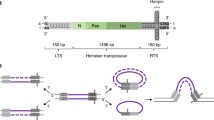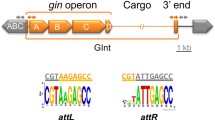Summary
The related transposons Tn501 and Tn1721 have a 3.8 kb region in common that contains two genes (tnpA and tnpR) and a resolution site (res) required for transposition. Resolvase, the product of tnpR, catalyses site-specific recombination at res, a 186 base pair (bp) sequence located adjacent to tnpR at one end of the homology region. We describe here identification of the crossover site within res. It involved the construction of a plasmid containing copies of res (Tn501) and res (Tn1721) in direct orientation and tnpR-mediated intramolecular recombination between the two homologous (but non-identical) sites. The resulting hybrid contained Tn501 and Tn1721 fused at the crossover point. DNA sequence analysis of the recombinant indicates that recombination occurs in an 11 bp region of exact homology between Tn501 and Tn1721. The recombination site lies 161–172 bp upstream of tnpR at the transition from homology to non-homology between Tn501 and Tn1721 suggesting that site-specific recombination may have played a role in the evolution of these elements.
Similar content being viewed by others
References
Altenbuchner J, Schmitt R (1983) Transposon Tn1721: site-specific recombination generates deletions and inversions. Mol Gen Genet 190:300–308
Altenbuchner J, Schmid K, Schmitt R (1983) Tn1721-encoded tetracycline resistance: mapping of structural and regulatory genes mediating resistance. J Bacteriol 153:116–123
Bennett PM, Grinsted J, Choi C-L, Richmond MH (1978) Characterisation of Tn501, a transposon determining resistance to mercuric ions. Mol Gen Genet 159:101–106
Bolivar F, Rodriguez RL, Greene PH, Betlach MC, Heynecker HL, Boyer HW (1977) Construction and characterization of new cloning vehicles. II. A multipurpose cloning system. Gene 2:97–113
Diver WP, Grinsted J, Fritzinger DC, Brown NL, Altenbuchner J, Rogowsky P, Schmitt R (1983) DNA sequences of and complementation by the tnpR genes of Tn21, Tn501 and Tn1721. Mol Gen Genet 181:189–193
Grindley NDF, Lauth MR, Wells RG, Wityk RJ, Salvo JJ, Reed RR (1982) Transposon-mediated site-specific recombination: identification of three binding sites for resolvase at the res sites of γδ and Tn3. Cell 30:19–27
Grinsted J, de la Cruz F, Altenbuchner J, Schmitt R (1982) Complementation of transposition of tnpA mutants of Tn3, Tn21, Tn501 and Tn1721. Plasmid 8:276–286
Heffron F (1983) Tn3 and its relatives. In: Shapiro JA (ed) Mobile Genetic Elements. Academic Press, New York, p 223
Krasnow MA, Cozzarelli NR (1983) Site-specific relaxation and recombination by the Tn3 resolvase: Recognition of the DNA path between oriented res sites. Cell 32:1313–1324
Maxam AM, Gilbert W (1980) Sequencing end-labelled DNA with base-specific chemical cleavages. Methods Enzymol 65:499–559
Reed RR (1981b) Resolution of cointegrates between transposons γδ and Tn3 defines the recombination site. Proc Natl Acad Sci USA 78:3428–3442
Reed RR (1981b) Transposon-mediated site-specific recombination: a defined in vitro system. Cell 25:713–719
Reed RR, Grindley NF (1981) Transposon-mediated site-specific recombination in vitro: DNA cleavage and protein DNA linkage at the recombination site. Cell 25:721–728
Schmitt R (1968) Analysis of melibiose mutants deficient in α-galactosidase and thiomethylgalactoside permease II in Escherichia coli K-12. J Bacteriol 96:462–471
Schmitt R, Bernhard E, Mattes R (1979) Characterisation of Tn1721, a new transposon containing tetracycline genes capable of amplification. Mol Gen Genet 172:53–65
Schmitt R, Altenbuchner J, Grinsted J (1981) Complementation of transposition functions encoded by transposons Tn501 (HgR) and Tn1721 (TnR). In: Levy SB, Clowes RC, Koenig EL (eds) Molecular biology, pathogenicity, and ecology of bacterial plasmids. Plenum Publ Co, New York, p 359
Schöffl F, Arnold W, Pühler A, Altenbuchner J, Schmitt R (1981) The tetracycline resistance transposons Tn1721 and Tn1771 have three 38-base pair repeats and generate five-base pair direct repeats. Mol Gen Genet 181:87–94
Wiebauer K, Schraml S, Shales SW, Schmitt R (1981) Tetracycline resistance transposon Tn1721: recA-dependent gene amplification and expression of tetracycline resistance. J Bacteriol 147:851–859
Author information
Authors and Affiliations
Additional information
Communicated by A. Böck
Rights and permissions
About this article
Cite this article
Rogowsky, P., Schmitt, R. Resolution of a hybrid cointegrate between transposons Tn501 and Tn1721 defines the recombination site. Molec. Gen. Genet. 193, 162–166 (1984). https://doi.org/10.1007/BF00327431
Received:
Issue Date:
DOI: https://doi.org/10.1007/BF00327431




